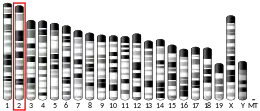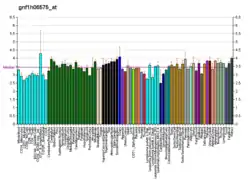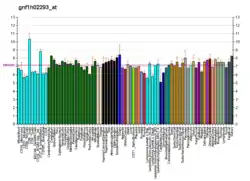CAPN3
Calpain-3 is a protein that in humans is encoded by the CAPN3 gene.[5][6]
Function
Calpain, a heterodimer consisting of a large and a small subunit, is a major intracellular protease, although its function has not been well established. This gene encodes a muscle-specific member of the calpain large subunit family that specifically binds to titin. Mutations in this gene are associated with limb-girdle muscular dystrophies type 2A. Alternate promoters and alternative splicing result in multiple transcript variants encoding different isoforms and some variants are ubiquitously expressed.[7]
In melanocytic cells CAPN3 gene expression may be regulated by MITF.[8]
References
- GRCh38: Ensembl release 89: ENSG00000092529 - Ensembl, May 2017
- GRCm38: Ensembl release 89: ENSMUSG00000079110 - Ensembl, May 2017
- "Human PubMed Reference:". National Center for Biotechnology Information, U.S. National Library of Medicine.
- "Mouse PubMed Reference:". National Center for Biotechnology Information, U.S. National Library of Medicine.
- Sorimachi H, Imajoh-Ohmi S, Emori Y, Kawasaki H, Ohno S, Minami Y, Suzuki K (December 1989). "Molecular cloning of a novel mammalian calcium-dependent protease distinct from both m- and mu-types. Specific expression of the mRNA in skeletal muscle". J. Biol. Chem. 264 (33): 20106–11. PMID 2555341.
- Richard I, Broux O, Allamand V, Fougerousse F, Chiannilkulchai N, Bourg N, Brenguier L, Devaud C, Pasturaud P, Roudaut C (May 1995). "Mutations in the proteolytic enzyme calpain 3 cause limb-girdle muscular dystrophy type 2A". Cell. 81 (1): 27–40. doi:10.1016/0092-8674(95)90368-2. PMID 7720071.
- "Entrez Gene: CAPN3 calpain 3, (p94)".
- Hoek KS, Schlegel NC, Eichhoff OM, Widmer DS, Praetorius C, Einarsson SO, Valgeirsdottir S, Bergsteinsdottir K, Schepsky A, Dummer R, Steingrimsson E (2008). "Novel MITF targets identified using a two-step DNA microarray strategy". Pigment Cell Melanoma Res. 21 (6): 665–76. doi:10.1111/j.1755-148X.2008.00505.x. PMID 19067971.
- Ono Y, Shimada H, Sorimachi H, Richard I, Saido TC, Beckmann JS, Ishiura S, Suzuki K (July 1998). "Functional defects of a muscle-specific calpain, p94, caused by mutations associated with limb-girdle muscular dystrophy type 2A". J. Biol. Chem. 273 (27): 17073–8. doi:10.1074/jbc.273.27.17073. PMID 9642272.
- Sorimachi H, Kinbara K, Kimura S, Takahashi M, Ishiura S, Sasagawa N, Sorimachi N, Shimada H, Tagawa K, Maruyama K (December 1995). "Muscle-specific calpain, p94, responsible for limb girdle muscular dystrophy type 2A, associates with connectin through IS2, a p94-specific sequence". J. Biol. Chem. 270 (52): 31158–62. doi:10.1074/jbc.270.52.31158. PMID 8537379.
Further reading
- Sorimachi H, Ishiura S, Suzuki K (1997). "Structure and physiological function of calpains". Biochem. J. 328 (3): 721–32. doi:10.1042/bj3280721. PMC 1218978. PMID 9396712.
- Kinbara K, Sorimachi H, Ishiura S, Suzuki K (1998). "Skeletal muscle-specific calpain, p49: structure and physiological function". Biochem. Pharmacol. 56 (4): 415–20. doi:10.1016/S0006-2952(98)00095-1. PMID 9763216.
- Sorimachi H, Ono Y, Suzuki K (2000). "Skeletal muscle-specific calpain, p94, and connectin/titin: their physiological functions and relationship to limb-girdle muscular dystrophy type 2A". Adv. Exp. Med. Biol. 481: 383–95, discussion 395-7. doi:10.1007/978-1-4615-4267-4_23. PMID 10987085.
- Baghdiguian S, Richard I, Martin M, Coopman P, Beckmann JS, Mangeat P, Lefranc G (2001). "Pathophysiology of limb girdle muscular dystrophy type 2A: hypothesis and new insights into the IkappaBalpha/NF-kappaB survival pathway in skeletal muscle". J. Mol. Med. 79 (5–6): 254–61. doi:10.1007/s001090100225. PMID 11485017.
- Canki-Klain N, Milic A, Kovac B, Trlaja A, Grgicevic D, Zurak N, Fardeau M, Leturcq F, Kaplan JC, Urtizberea JA, Politano L, Piluso G, Feingold J (2004). "Prevalence of the 550delA mutation in calpainopathy (LGMD 2A) in Croatia". Am. J. Med. Genet. A. 125A (2): 152–6. doi:10.1002/ajmg.a.20408. PMID 14981715.
- Kramerova I, Beckmann JS, Spencer MJ (2007). "Molecular and cellular basis of calpainopathy (limb girdle muscular dystrophy type 2A)" (PDF). Biochim. Biophys. Acta. 1772 (2): 128–44. doi:10.1016/j.bbadis.2006.07.002. PMID 16934440.
- Ohno S, Minoshima S, Kudoh J, Fukuyama R, Shimizu Y, Ohmi-Imajoh S, Shimizu N, Suzuki K (1990). "Four genes for the calpain family locate on four distinct human chromosomes". Cytogenet. Cell Genet. 53 (4): 225–9. doi:10.1159/000132937. PMID 2209092.
- Sorimachi H, Kinbara K, Kimura S, Takahashi M, Ishiura S, Sasagawa N, Sorimachi N, Shimada H, Tagawa K, Maruyama K (1995). "Muscle-specific calpain, p94, responsible for limb girdle muscular dystrophy type 2A, associates with connectin through IS2, a p94-specific sequence". J. Biol. Chem. 270 (52): 31158–62. doi:10.1074/jbc.270.52.31158. PMID 8537379.
- Fardeau M, Hillaire D, Mignard C, Feingold N, Feingold J, Mignard D, de Ubeda B, Collin H, Tome FM, Richard I, Beckmann J (1996). "Juvenile limb-girdle muscular dystrophy. Clinical, histopathological and genetic data from a small community living in the Reunion Island". Brain. 119 (1): 295–308. doi:10.1093/brain/119.1.295. PMID 8624690.
- Corasaniti MT, Navarra M, Catani MV, Melino G, Nisticò G, Finazzi-Agrò A (1996). "NMDA and HIV-1 coat protein, GP120, produce necrotic but not apoptotic cell death in human CHP100 neuroblastoma cultures via a mechanism involving calpain". Biochem. Biophys. Res. Commun. 229 (1): 299–304. doi:10.1006/bbrc.1996.1796. PMID 8954122.
- Richard I, Brenguier L, Dinçer P, Roudaut C, Bady B, Burgunder JM, Chemaly R, Garcia CA, Halaby G, Jackson CE, Kurnit DM, Lefranc G, Legum C, Loiselet J, Merlini L, Nivelon-Chevallier A, Ollagnon-Roman E, Restagno G, Topaloglu H, Beckmann JS (1997). "Multiple independent molecular etiology for limb-girdle muscular dystrophy type 2A patients from various geographical origins". Am. J. Hum. Genet. 60 (5): 1128–38. PMC 1712426. PMID 9150160.
- Kinbara K, Sorimachi H, Ishiura S, Suzuki K (1997). "Muscle-specific calpain, p94, interacts with the extreme C-terminal region of connectin, a unique region flanked by two immunoglobulin C2 motifs". Arch. Biochem. Biophys. 342 (1): 99–107. doi:10.1006/abbi.1997.0108. PMID 9185618.
- Pratt VM, Jackson CE, Wallace DC, Gurley DS, Feit A, Feldman GL (1997). "DNA studies of limb-girdle muscular dystrophy type 2A in the Amish exclude a modifying mitochondrial gene and show no evidence for a modifying nuclear gene". Am. J. Hum. Genet. 61 (1): 231–3. doi:10.1016/S0002-9297(07)64296-7. PMC 1715865. PMID 9246005.
- Dinçer P, Leturcq F, Richard I, Piccolo F, Yalnizoglu D, de Toma C, Akçören Z, Broux O, Deburgrave N, Brenguier L, Roudaut C, Urtizberea JA, Jung D, Tan E, Jeanpierre M, Campbell KP, Kaplan JC, Beckmann JS, Topaloglu H (1997). "A biochemical, genetic, and clinical survey of autosomal recessive limb girdle muscular dystrophies in Turkey". Ann. Neurol. 42 (2): 222–9. doi:10.1002/ana.410420214. PMID 9266733.
- Ono Y, Shimada H, Sorimachi H, Richard I, Saido TC, Beckmann JS, Ishiura S, Suzuki K (1998). "Functional defects of a muscle-specific calpain, p94, caused by mutations associated with limb-girdle muscular dystrophy type 2A". J. Biol. Chem. 273 (27): 17073–8. doi:10.1074/jbc.273.27.17073. PMID 9642272.
- Pénisson-Besnier I, Richard I, Dubas F, Beckmann JS, Fardeau M (1998). "Pseudometabolic expression and phenotypic variability of calpain deficiency in two siblings". Muscle Nerve. 21 (8): 1078–80. doi:10.1002/(SICI)1097-4598(199808)21:8<1078::AID-MUS15>3.0.CO;2-Q. PMID 9655129.
- Urtasun M, Sáenz A, Roudaut C, Poza JJ, Urtizberea JA, Cobo AM, Richard I, García Bragado F, Leturcq F, Kaplan JC, Martí Massó JF, Beckmann JS, López de Munain A (1998). "Limb-girdle muscular dystrophy in Guipúzcoa (Basque Country, Spain)". Brain. 121 (9): 1735–47. doi:10.1093/brain/121.9.1735. PMID 9762961.
- Huang Y, de Morrée A, van Remoortere A, Bushby K, Frants RR, den Dunnen JT, van der Maarel SM (2008). "Calpain 3 is a modulator of the dysferlin protein complex in skeletal muscle". Hum. Mol. Genet. 17 (12): 1855–66. doi:10.1093/hmg/ddn081. PMC 2900895. PMID 18334579.
External links
- The MEROPS online database for peptidases and their inhibitors: C02.004
- GeneReviews/NCBI/NIH/UW entry on Calpainopathy
- LOVD mutation database: CAPN3
- Human CAPN3 genome location and CAPN3 gene details page in the UCSC Genome Browser.
This article is issued from Wikipedia. The text is licensed under Creative Commons - Attribution - Sharealike. Additional terms may apply for the media files.







